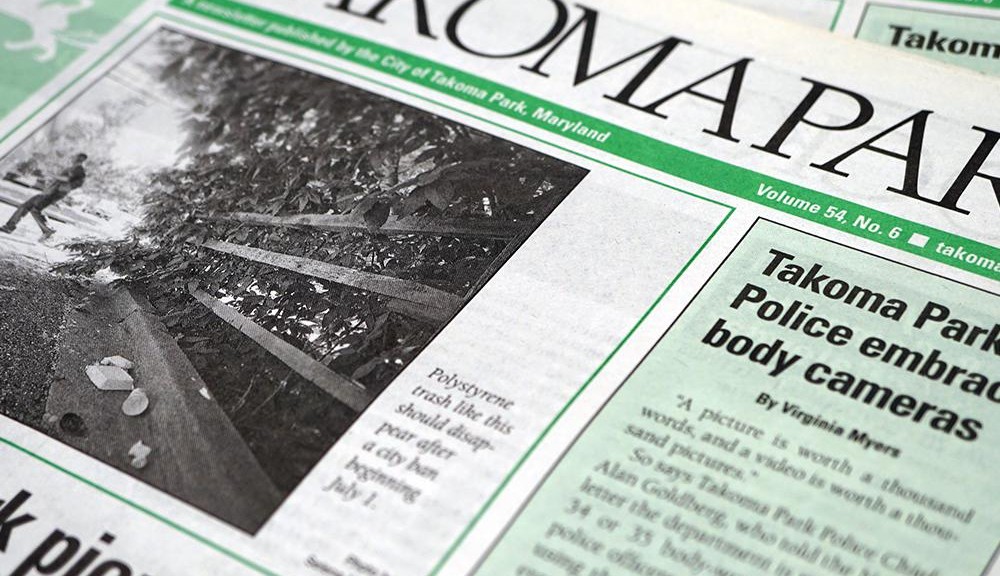By Kevin Adler
Anyone who’s driven through the busy intersection of New Hampshire Avenue and University Boulevard in the last few months has noticed the white girders soaring 30 feet in the air, forming a sleek, modern structure where a Taco Bell once stood.
The Takoma-Langley Crossroads Transit Center is well on its way to transforming the travel experience for thousands of daily bus riders. Built by the Maryland Transportation Authority for $34 million (construction and land acquisition), the facility is on schedule for completion this fall, says Paul Shepard, an MTA spokesman.
“It’s the first major investment in infrastructure here in decades. It’s modernlooking…physically, it looks like there’s something happening here,” says Melanie Isis, executive director of the Takoma/ Langley Crossroads Development Authority (Crossroads), which represents business owners in the area.
MTA is building the facility, and then handing over operations to the Washington Metropolitan Area Transit Authority (WMATA), which will complete the finishing touches for a grand opening expected by the end of this year.
“The Transit Center will put all the bus passengers in one place, with easy access to their buses and transfers”
For WMATA, the Transit Center will streamline travel through what it calls the busiest non-Metrorail station transfer point in the Washington region. WMATA has found that up to 12,000 bus riders per day pass through the Crossroads area.
Under a translucent glass roof, the Transit Center will accommodate as many as 12 buses at a time. It will serving a dizzying array of routes operated by Prince Georges County, Montgomery County, WMATA and University of Maryland—as many as 60 buses per hour move through the area during rush hour.
Pedestrian safety and comfort is the biggest, most immediate benefit of the new development. “The Transit Center will put all the bus passengers in one place, with easy access to their buses and transfers,” says Erkin Ozberk, planner for the City of Takoma Park, and liaison with MTA and WMATA.
“It’s a bright, secure, sheltered facility with public restrooms. If you’re waiting for a bus, you won’t have to do it four feet from New Hampshire Avenue, exposed to the rain,” he adds. “If you’re transferring buses, you won’t have to run across busy lanes of traffic. And if you’re arriving on foot, there are new ‘signalized’ pedestrian crosswalks for the first time.”
Crosswalks and wider sidewalks also will help patrons of the stores and businesses in the area, says Isis. “So many people are in a one-mile radius, and many of them do not own cars. The Crossroads is where they walk to do their errands,” she says.
Drivers will benefit, too, because buses will conduct passenger pickups and dropoffs in the Transit Center. Because buses won’t be stopping in the right-hand lanes on New Hampshire and University, traffic flow will likely improve.
As important as it is to improve bus riders’ experience, the Transit Center could have an impact beyond transportation, says Reemberto Rodriguez, director of the Silver Spring Regional Center, which includes the Montgomery County part of the Crossroads area.
“Takoma-Langley is ‘undiscovered country,’ but very appealing to millennials moving to Silver Spring,” he says. “I’m totally convinced they will see TakomaLangley as the Columbia Heights we no longer have. They’re only a 10-minute bus ride from downtown Silver Spring.”
Plus, the Transit Center is perfectly situated if the Purple Line light-rail from New Carrollton to Bethesda is built. The Transit Center is, literally, the midpoint on the Purple Line, the 11th of 21 stations, Rodriguez pointed out. “It has the potential to be transformative,” he says.
And although the Purple Line has not yet been given the final green light (see page 7), the Transit Center has been designed with it in mind. The TakomaLangley Purple Line station would be in the median on University Boulevard, with safe access to and from the bus lines.
Even without the Purple Line, Takoma Park city officials view the Transit Center as an invitation for property and business owners to invest in the area. “We are optimistic that it signals investments being made in the Crossroads area, and that might spur property owners to make upgrades,” says Ozberk. “Also, we hope that the bold, crisp design might set a precedent for any redevelopment.”
This article appeared in the July 2015 edition of the Takoma Park Newsletter. The Takoma Park Newsletter is available for download here.

